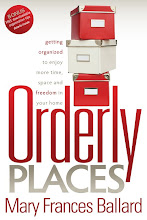This month we
are concentrating on books and hobbies.
Since there are so many types of hobbies and since we often take on too
many, this blog will be a long one. I
have gone into more detail in my book, but you can begin with these tips.
Books
- Keeping fiction books that you have read serve no purpose except to prove you own them. Sell or donate them knowing you can borrow it from the library if you have time to read it again.
- Non-fiction books should be grouped by category. Since information is always changing, using older books as reference many not provide recent findings. Let them go and use the Internet to find the latest information. The books are not your brain and letting them go will not cause you to forget what you have learned. (Old age, however, may cause you to forget. I speak from experience.)
- Make friends with the library.
- Use vertical areas to provide extra shelves or cabinets for storage.
Hobbies
- Limit the number of hobbies you take on: two is best or three if it is related to the one of the others.
- Do not try to purchase every new tool or supply for that craft when it comes along. Most specialty gadgets are rarely used and take up valuable space.
- Finish one project before you start another one. I know that is difficult when classes come along to teach a new technique. Go to the class and take notes if you must, but do not start another project.
- Purchase kits when they are suitable. It will save you time in making choices and money in purchasing supplies you don’t use.
- Use storage containers designed for your items if they are convenient for you to use. It is usually the most efficient use of space. If those are too expensive, try to find a less expensive but similar substitute container in the fishing tackle, laundry or kitchen storage area of the store.
- Consider over the door style shoe bags with clear pockets for sorting and storing small items.
- Portable totes, rolling carts or drawers, wheeled suitcases and crates are all options when space is limited.
- Fill the closet in a spare room with shelving for containers or stacking drawers for your craft items.
- Folding or card tables can be used for projects if no other surfaces are suitable for your projects. These can be stored under beds, behind tall furniture or in other storage areas.
- Purge items you have not used and realize now you probably will never use. Our tastes and preferences change over time and there is no point in keeping something just because you thought you might use it. Sell or donate it to your craft group or guild.
- Store craft magazines and how to booklets in a magazine holder. When it is filled, use the one in one out principle.
- Use peg boards to store tools and supplies that are used often.
- Convert chests, china cabinets and other furniture into attractive storage for your supplies..
- Discard unflattering, foggy or distorted photos.
- Invest in a digital camera and begin using online services to create scrapbooks, calendars, cards and more.
- Consider scanning older quality photos rather than saving them for scrapbooks. Companies that offer those services are listed in the resource section.
- Plan a photo give away day for those photos you no longer need or want.
- Shoe boxes or similar photo boxes can be used to store saved photos.
- If upgrading to equipment or supplies with more features, sell or donate the equipment and supplies it replaces. Do not keep it just in case you might need it.
- Use crafting/sewing tables with adjustable legs so it can be lowered to a comfortable level.
- Divided plastic drawer sets and towers can be used to store supplies.
- Purge patterns and fabrics and sell or donate those you no longer use or like.
- Create a cutting/project/pressing table by placing a table on bed risers to make the height more back and neck friendly. Cover it with a padded board for pressing. A cutting mat can be placed on top of this as the need arises.
- Keep projects portable in the extra large zip top bags.
- Consider fishing tackle boxes for sorting and storage
of small notions, beads, wires and tools.
- Store stacks of containers on shelves in bookcases or cabinets with identifying labels on the front edge.
- Save only very special greeting cards you have received. Cut off the verse and name of the giver to save and discard the front and envelope.
- Make memories of sentimental items by creating shadow boxes, framed photo collages, pillow tops, album covers or quilts. These can be passed on to other generations.
- Make a child’s craft kit by storing the supplies in a zip top big bag. Everything will be ready for them to use and clean up will be simple.
- Eliminate excessive gift wrapping supplies by investing in one or two rolls of paper. White or paper bag brown can be used for any occasion. They can be decorated with markers or rubber stamps or left plain with a pretty bow. Store in a flat container under the bed or in containers designed for them. Keeping one bright and one pastel roll of ribbon is sufficient.
- Use special ribbon holders if you maintain several rolls. These make it convenient for you to pull off one ribbon at a time.
Collections
- Valuable collections such as rare coins or jewelry should be appraised, inventoried and stored in a safe place.
- Purge items you have collected but have no sentimental value and you do not want to display. See if a family member wants them before selling or donating.
- Have pictures taken of you with the item before removing it if you no longer have room for it.
- Limit the items you collect to the space that you have to display them. If you insist on storing some of them elsewhere, rotate them through your display so you can enjoy what you have.
- Group your collections together for the most attractive arrangements.
- The best collectible is money. Save it in interest bearing accounts rather than spending in on other items to collect. It takes no storage space and grows in value.

